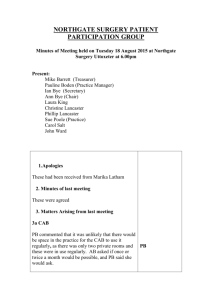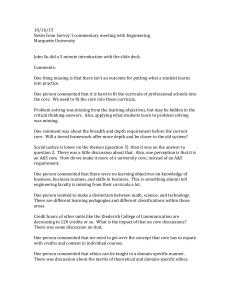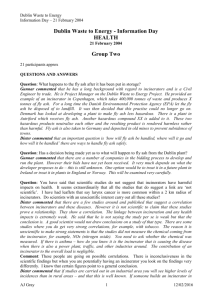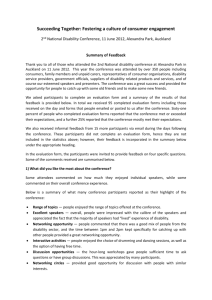Session 1 - Dublin Waste To Energy
advertisement
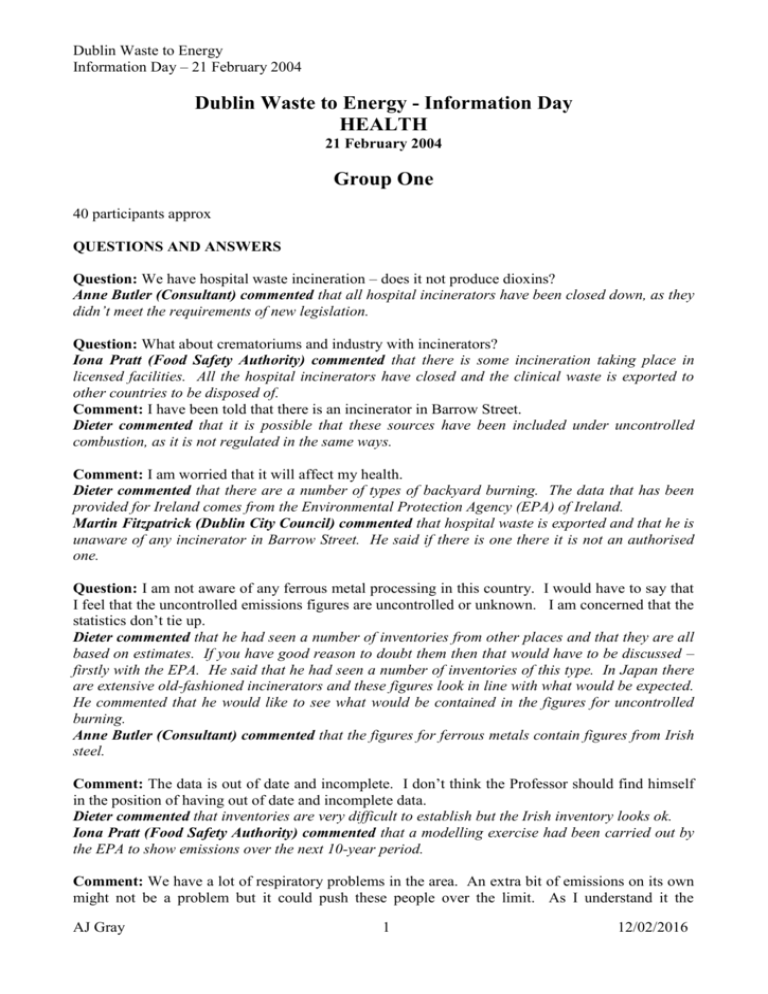
Dublin Waste to Energy Information Day – 21 February 2004 Dublin Waste to Energy - Information Day HEALTH 21 February 2004 Group One 40 participants approx QUESTIONS AND ANSWERS Question: We have hospital waste incineration – does it not produce dioxins? Anne Butler (Consultant) commented that all hospital incinerators have been closed down, as they didn’t meet the requirements of new legislation. Question: What about crematoriums and industry with incinerators? Iona Pratt (Food Safety Authority) commented that there is some incineration taking place in licensed facilities. All the hospital incinerators have closed and the clinical waste is exported to other countries to be disposed of. Comment: I have been told that there is an incinerator in Barrow Street. Dieter commented that it is possible that these sources have been included under uncontrolled combustion, as it is not regulated in the same ways. Comment: I am worried that it will affect my health. Dieter commented that there are a number of types of backyard burning. The data that has been provided for Ireland comes from the Environmental Protection Agency (EPA) of Ireland. Martin Fitzpatrick (Dublin City Council) commented that hospital waste is exported and that he is unaware of any incinerator in Barrow Street. He said if there is one there it is not an authorised one. Question: I am not aware of any ferrous metal processing in this country. I would have to say that I feel that the uncontrolled emissions figures are uncontrolled or unknown. I am concerned that the statistics don’t tie up. Dieter commented that he had seen a number of inventories from other places and that they are all based on estimates. If you have good reason to doubt them then that would have to be discussed – firstly with the EPA. He said that he had seen a number of inventories of this type. In Japan there are extensive old-fashioned incinerators and these figures look in line with what would be expected. He commented that he would like to see what would be contained in the figures for uncontrolled burning. Anne Butler (Consultant) commented that the figures for ferrous metals contain figures from Irish steel. Comment: The data is out of date and incomplete. I don’t think the Professor should find himself in the position of having out of date and incomplete data. Dieter commented that inventories are very difficult to establish but the Irish inventory looks ok. Iona Pratt (Food Safety Authority) commented that a modelling exercise had been carried out by the EPA to show emissions over the next 10-year period. Comment: We have a lot of respiratory problems in the area. An extra bit of emissions on its own might not be a problem but it could push these people over the limit. As I understand it the AJ Gray 1 12/02/2016 Dublin Waste to Energy Information Day – 21 February 2004 contractor will be thinking of operating cost. If it is not the best plant from a health point of view we are in difficulties. Comment: 2-3 nights ago there was a TV programme - Duncan Stewarts. There are dozens of people burning household waste in their back gardens. We sell things that are used to burn leaves but it is illegal to burn household waste in them – this is a problem. Comment: I was involved with Tributyl tin. With this they were finding more severe effects at lower levels - eventually the law was changed in terms of having Tributyl tin in paints. 0.00000 means nothing to people, this should be put it into time which is more meaningful. We did this with Tributyl tin and it was something like 1 second in the whole of time. I would suggest that instead of ng the data should be put in terms of time or something that is more meaningful. Question: When did the new technology start? What is the definition of modern versus old? Dieter commented that the EU directive was implemented in Germany in 1990. The standards were implemented earlier. We have been running at these levels for about 20 years. Question: Is monitoring also carried out in the vicinity of landfills and transhipment stations? Dieter commented that the landfilling of fly ash goes on but there is also monitoring. A couple of years ago there was monitoring of the blood of personnel handling fly ash material – this is documented. The levels of dioxins in mother’s milk have been going down and this is in part a result of the Clean Air Act. He said he is fairly confident that with incineration the environment will improve and as time goes on the environment will nevertheless improve - this is very safe technology. Dioxins were around 10,000 years ago. Comment: I was using Tributyl tin as an illustration of what can happen. It was used in nurse’s uniforms and floors etc. People were not absorbing it from that though; it was the guys spraying it in ship yards. Dieter commented that you always have to be alert. He said that his view was that incineration technology is tested and established. Question: What are the standards that are likely to be used for PM25 (particle size of 25 parts per million)? What are the EU standards based on – is it scientific studies that say that dioxins are safe to human health? Dieter commented that there are standards for dioxin which is an acceptable daily intake via food. This is based on toxicological discussions and evaluations – Risk Assessment. It is not possible to relate tolerable daily intake to waste incineration. You cannot breath it so you have to do the calculations via transfer, dust to plant, plant to food, food to human and to children etc. This is complicated and requires lots of studies. The 0.1 limit is acceptable as the dilution level causes a level much lower than what see in ambient air - 1% or less is acceptable. Dust is regulated. PM10 means small particles below a certain level. It is very difficult to measure in a reliable way. There are also so many sources of PM10 agriculture, traffic and so on. Data shows that modern incinerators show very low emissions of PM10 so it is comparable to a few cars – I can give you the data. Question: I saw a study last year which related to problems within a radius of an incinerator. I am concerned when you say that you cannot do proper biological tests in a mixed area. That is like saying that you will not be able to point to health effects of incinerators because of background levels. There are such a lot of levels in Dublin that you would not be able to isolate. AJ Gray 2 12/02/2016 Dublin Waste to Energy Information Day – 21 February 2004 Dieter commented that we know about the emissions and what is coming out of the stack. It is highly likely that there will be an impact. Anywhere where you go you deal with mixed exposure, burning, heating is everywhere. The way out of this difficulty from my point of view is to compare emissions, and look at the compound causing it and where does it come from. Epidemiologists can monitor small effects but cannot monitor within the background range. Comment: If you have an incident and it is never recorded you would never know? Dieter commented that the type of incineration (which is not specified yet but will be by the developer) has been monitored continuously in specific places. What happens in the case of incineration in relation to incidents? This could be a bunker fire, an uncontrolled fire – this would be part of the impact studies and is part of an EIS. It is very rare and would maybe last a few hours. The worse case scenario is the smoke. You cannot compare this to a worst-case scenario in a nuclear plant - which some people do. Comment: You said there is a cumulative effect of particulate matter from traffic and from incinerators – possibly with heavy metals. There is also the possibility of a spill in the transport of fly ash. As far as I know the individual compounds monitored on their own cannot harm anyone but if you have all of these different factors it is cumulative. I would want to see studies if there are any. Dieter commented that studies have been done in tissue culture where fly ash can be applied – this meant we could be sure that the toxicity is as predicted. Dioxins cause toxicity but they do not add in a synergistic way but an additive way. Do they accumulate – yes, this is perfectly reflected by levels in mothers milk. Where do the molecules go – they are partially destroyed over time but this does not hold true for cadmium, lead, and arsenic – these should be decreased to as low a level as possible. You need to talk about products, not municipal waste incineration. If these compounds were eliminated from products, for example, batteries, paint etc we would not be able to find it in fly ash anymore. A spill of fly ash has to be avoided and precautions need to be taken against spillage of anything – this has to be looked at. Question: What effect does dioxin have on human and animal fertility? Dieter commented that fertility tests were done in Seveso where there was a high exposure of one particular dioxin. The plant in northern Italy showed that there were effects on skin, acne etc these were the major effects. From animal experiments we know that dioxin affects fertility but that requires a really relatively high level. The fact that it accumulates at low levels shows it does not have an effect. Dioxins have an additive effect, one replaces another. Some are more toxic than others. Gunner commented that in Seveso the type of dioxin released was considered the most toxic. In toxicology you take dioxins and convert them to the worst possible case. That was in a chemical plant and it released 30 kg in an area of 40 hectares in few seconds. Ireland will have 7 incinerators which will release 0.5 g dioxin per year over the size of the entire country - that is not very much at all. The effects in Seveso were temporary. Question: In post mortems is account taken of dioxins present in the corpse of someone that has just died? That is the only way to get the level in the body. Dieter commented that a dead person would show you no more than a living one. It is not known how much dioxin would kill a human being. Question: Is there a way of treating fly ash chemically? BNFL came up with system of dealing with contaminated clothing etc. They found that they could break down lots of low level stuff without having to treat it was heavily contaminated. AJ Gray 3 12/02/2016 Dublin Waste to Energy Information Day – 21 February 2004 Dieter commented that fly ash can be treated and other constituents can be removed to reduce the volume, for example, salts. He suggested that the community should look at what any developer provides. What will they do with the fly ash and which technology they will provide? Comment: Over the last 7 years whilst living here my respiration has become worse. It’s another thing that is adding to problem. Ultimately incineration is another problem to an area that already has problems. The sewage plant is not right and it’s going on and on. AJ Gray 4 12/02/2016
